Davos
| Davos | ||||||||||
|---|---|---|---|---|---|---|---|---|---|---|
| Top left: Weissfluhjoch, Top right: World Economic Forum congress centre, Bottom: View over Davos and the Parsenn ski area by night | ||||||||||
|
||||||||||
| Population | 11,248 (Dec 2009)[1] | |||||||||
| - Density | 40 /km2 (103 /sq mi) | |||||||||
| Area | 283.99 km2 (109.65 sq mi) | |||||||||
| Elevation | 1,560 m (5,118 ft) | |||||||||
| Postal code | 7260 Davos-Dorf 7270 Davos-Platz |
|||||||||
| SFOS number | 3851 | |||||||||
| Surrounded by | Arosa, Bergün/Bravuogn, Klosters-Serneus, Langwies, S-chanf, Susch, Wiesen | |||||||||
| Twin towns | Aspen (USA), Sanada (Japan), Chamonix (France) | |||||||||
| Website | www.gemeinde-davos.ch SFSO statistics |
|||||||||
 Davos
|
||||||||||
| View map of Davos | ||||||||||
Davos (Romansh: Tavau, Italian: Tavate) is a municipality in the district of Prättigau/Davos in the canton of Graubünden, Switzerland.
It is located on the Landwasser River, in the Swiss Alps, between the Plessur and Albula Range. At 1,560 meters (5,118 ft), it is the highest city in Europe.[2]
Davos has a dual claim to fame as the host to the World Economic Forum (WEF), an annual meeting of global political and business elites (often referred to simply as Davos), and the home of the largest ski resort in Switzerland, serving as the site of the annual Spengler Cup ice hockey tournament, hosted by the HC Davos local hockey team.
Contents |
History
The current settlement of the Davos area started back in High Middle Ages with the immigration of Rhaeto-Romans. The village of Davos is first mentioned in 1213 as Tavaus.[3] From about 1280 the barons of Vaz allowed German-speaking Walser colonists to settle down, and conceded them extensive self-administration rights, causing Davos to become the largest Walser settlement area in eastern Switzerland. Natives still speak a dialect that is atypical for Graubünden, showing similarities with German idioms of western parts of Switzerland, such as in Bernese Oberland and the Upper Valais
In 1436, the League of the Ten Jurisdictions was founded in Davos.
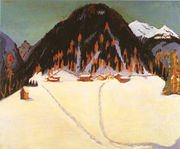
From the middle of the 18th century, Davos became a popular destination for both the rich and the ailing because the microclimate in the high valley was deemed excellent by doctors and recommended for lung disease patients. Between 1936 and 1938, Ernst Ludwig Kirchner, then at the end of his life, depicted Davos and the Junkerboden. His painting has a both romantic and pantheistic atmosphere and simplified formal structure. Robert Louis Stevenson, who suffered from tuberculosis, wintered in Davos in 1880 at the recommendation of his Edinburgh physician Dr. George Balfour. Arthur Conan Doyle wrote an article about skiing in Davos in 1899. A sanatorium in Davos is also the setting of the Thomas Mann novel Der Zauberberg (The Magic Mountain).
The only European Bandy Championship was held in the town in 1913 with England victorious.[4]
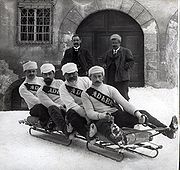
In the "natural ice" era of winter sports, Davos, and the Davos Eisstadion was a mecca for speed skating. Many international championships were held here, and many world records were set, beginning with Peder Østlund who set four records in 1898.
Subsequently, Davos became a famous ski resort, especially frequented by tourists from the United Kingdom and the Netherlands. After peaking in the 1970s and 1980s, the city settled down as a leading but less high-profile tourist attraction.
Pronunciation
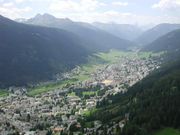
English-speaking broadcast journalists covering the World Economic Forum's Annual Meeting, along with many speakers at the meeting itself, commonly pronounce the town's name by emphasizing the first syllable and shortening the o to make the word rhyme with "moss", i.e., /ˈdɑːvɒs/ DAH-voss. The local pronunciation is [daˈvoːs].
Geography

Davos has an area, as of 2006[update], of 254.5 square kilometers (98.3 sq mi). Of this area, 37.1% is used for agricultural purposes, while 19.7% is forested. Of the rest of the land, 2.2% is settled (buildings or roads) and the remainder (41%) is non-productive (rivers, glaciers or mountains).[5]
The municipality is located in the Davos sub-district of the Prättigau/Davos district in the Landwasser valley. In terms of area, it is the second largest city in Switzerland and the largest in the canton of Graubünden. It consists of the village of Davos which is made up of five sections (Davos-Dorf, Davos-Platz, Frauenkirch, Glaris and Monsteinand) and the hamlets of Laret, Wolfgang, Clavadel and Spina in the main valley. In the side valleys there are additional hamlets including; Flüela, Dischma and Sertig.
Demographics
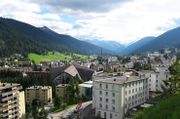
Davos has a population (as of 31 December 2009) of 11,248.[1] As of 2008[update], 23.7% of the population was made up of foreign nationals.[6] Over the last 10 years the population has decreased at a rate of -5.5%. Most of the population (as of 2000[update]) speaks German (86.3%), with Serbo-Croatian being second most common ( 2.8%) and Italian being third ( 2.7%).[5]
As of 2000[update], the gender distribution of the population was 49.1% male and 50.9% female.[7] The age distribution, as of 2000[update], in Davos is; 1,102 children or 9.7% of the population are between 0 and 9 years old and 1,435 teenagers or 12.6% are between 10 and 19. Of the adult population, 1,733 people or 15.2% of the population are between 20 and 29 years old. 1,897 people or 16.6% are between 30 and 39, 1,806 people or 15.8% are between 40 and 49, and 1,498 people or 13.1% are between 50 and 59. The senior population distribution is 902 people or 7.9% of the population are between 60 and 69 years old, 677 people or 5.9% are between 70 and 79, there are 318 people or 2.8% who are between 80 and 89 there are 49 people or 0.4% who are between 90 and 99.[6]
In the 2007 federal election the most popular party was the FDP which received 36.3% of the vote. The next three most popular parties were the SVP (30.1%), the SP (23.1%) and the CVP (7.4%).[5]
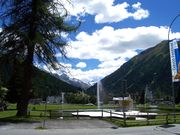
The entire Swiss population is generally well educated. In Davos about 74% of the population (between age 25-64) have completed either non-mandatory upper secondary education or additional higher education (either University or a Fachhochschule).[5]
Davos has an unemployment rate of 0.85%. As of 2005[update], there were 239 people employed in the primary economic sector and about 86 businesses involved in this sector. 1,118 people are employed in the secondary sector and there are 123 businesses in this sector. 5,565 people are employed in the tertiary sector, with 615 businesses in this sector.[5]
From the 2000 census[update], 3,950 or 34.6% are Roman Catholic, while 5,321 or 46.6% belonged to the Swiss Reformed Church. Of the rest of the population, there are 10 individuals (or about 0.09% of the population) who belong to the Christian Catholic faith, there are 439 individuals (or about 3.85% of the population) who belong to the Orthodox Church, and there are 274 individuals (or about 2.40% of the population) who belong to another Christian church. There are 8 individuals (or about 0.07% of the population) who are Jewish, and 79 (or about 0.69% of the population) who are Islamic. There are 56 individuals (or about 0.49% of the population) who belong to another church (not listed on the census), 832 (or about 7.29% of the population) belong to no church, are agnostic or atheist, and 448 individuals (or about 3.92% of the population) did not answer the question.[6]
The historical population is given in the following table:[3]
| year | population |
|---|---|
| 1850 | 1,680 |
| 1888 | 3,891 |
| 1900 | 8,089 |
| 1930 | 11,164 |
| 1950 | 10,433 |
| 2000 | 11,417 |
Weather
Davos has an average of 126.7 days of rain per year and on average receives 999 mm (39.3 in) of precipitation. The wettest month is August during which time Davos receives an average of 135 mm (5.3 in) of precipitation. During this month there is precipitation for an average of 13.6 days. The month with the most days of precipitation is June, with an average of 14.2, but with only 120 mm (4.7 in) of precipitation. The driest month of the year is April with an average of 55 mm (2.2 in) of precipitation over 13.6 days.[8]
| Climate data for Davos | |||||||||||||
|---|---|---|---|---|---|---|---|---|---|---|---|---|---|
| Month | Jan | Feb | Mar | Apr | May | Jun | Jul | Aug | Sep | Oct | Nov | Dec | Year |
| Source: MeteoSchweiz [8] | |||||||||||||
Sport
The six main ski areas are:
- Parsenn / Gotschna
- Jakobshorn
- Pischahorn
- Rinerhorn
- Schatzalp
- Madrisahorn
Events
On 14 March 2003, Winterjam was held and famous bands played during the event such as, Sum 41, Crazy Town, and Guano Apes.[9]
In popular culture
The town was featured in a episode of Viva La Bam, where they were visiting cities around Europe.
Heritage sites of national significance
Davos is home to seven sites that are listed as Swiss heritage sites of national significance. These heritage sites include the Town Archives, the Kirchner Museum, the Grosses Jenatschhaus (a type of charity house known as a Pfrundhaus) and the Forest Cemetery (Waldfriedhof). Several hotels and spas are also included on the list. The three hotels or former hotels are; Berghotel Schatzalp, the former Grand Hotel Belvédère and the Zürcher Höhenklinik von R. Gaberel.[10]
 Kirchner Museum |
See also
- Lake Davos
- Schwarzsee (Davos)
- World Economic Forum
- Davos Man
- List of ski areas and resorts in Switzerland
References
- ↑ 1.0 1.1 Swiss Federal Statistical Office, MS Excel document – Bilanz der ständigen Wohnbevölkerung nach Kantonen, Bezirken und Gemeinden (German) accessed 25 August 2010
- ↑ Davos bestmountaintown.com. Retrieved on 2010-01-27
- ↑ 3.0 3.1 Davos in German, French and Italian in the online Historical Dictionary of Switzerland.
- ↑ [1]
- ↑ 5.0 5.1 5.2 5.3 5.4 Swiss Federal Statistical Office accessed 28-Oct-2009
- ↑ 6.0 6.1 6.2 Graubunden Population Statistics (German) accessed 21 September 2009
- ↑ Graubunden in Numbers (German) accessed 21 September 2009
- ↑ 8.0 8.1 "Temperature and Percipitation Average Values-Table, 1961-1990" (in German, French, Italian). Federal Office of Meteorology and Climatology - MeteoSwiss. http://www.meteoswiss.admin.ch/web/de/klima/klima_schweiz/tabellen.html. Retrieved 8 May 2009., the weather station elevation is 1594 meters above sea level.
- ↑ SkisnowboardEurope.com
- ↑ Swiss inventory of cultural property of national and regional significance 21.11.2008 version, (German) accessed 28-Oct-2009
External links
- Davos.ch - Official website tourism information
- The Junkerboden under Snow in Davos from Kirchner, in YOUR CITY AT THE THYSSEN, a Thyssen Museum's project on Flickr
- Pictures Davos
- Municipality of Davos (German) - Official website
- Martin Bundi: Davos in Romansh, German, French and Italian in the online Historical Dictionary of Switzerland.
|
|||||||
